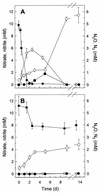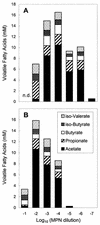N2O-producing microorganisms in the gut of the earthworm Aporrectodea caliginosa are indicative of ingested soil bacteria
- PMID: 12620856
- PMCID: PMC150113
- DOI: 10.1128/AEM.69.3.1655-1661.2003
N2O-producing microorganisms in the gut of the earthworm Aporrectodea caliginosa are indicative of ingested soil bacteria
Abstract
The main objectives of this study were (i) to determine if gut wall-associated microorganisms are responsible for the capacity of earthworms to emit nitrous oxide (N(2)O) and (ii) to characterize the N(2)O-producing bacteria of the earthworm gut. The production of N(2)O in the gut of garden soil earthworms (Aporrectodea caliginosa) was mostly associated with the gut contents rather than the gut wall. Under anoxic conditions, nitrite and N(2)O were transient products when supplemental nitrate was reduced to N(2) by gut content homogenates. In contrast, nitrite and N(2)O were essentially not produced by nitrate-supplemented soil homogenates. The most probable numbers of fermentative anaerobes and microbes that used nitrate as a terminal electron acceptor were approximately 2 orders of magnitude higher in the earthworm gut than in the soil from which the earthworms originated. The fermentative anaerobes in the gut and soil displayed similar physiological functionalities. A total of 136 N(2)O-producing isolates that reduced either nitrate or nitrite were obtained from high serial dilutions of gut homogenates. Of the 25 representative N(2)O-producing isolates that were chosen for characterization, 22 isolates exhibited >99% 16S rRNA gene sequence similarity with their closest cultured relatives, which in most cases was a soil bacterium, most isolates were affiliated with the gamma subclass of the class Proteobacteria or with the gram-positive bacteria with low DNA G+C contents, and 5 isolates were denitrifiers and reduced nitrate to N(2)O or N(2). The initial N(2)O production rates of denitrifiers were 1 to 2 orders of magnitude greater than those of the nondenitrifying isolates. However, most nondenitrifying nitrate dissimilators produced nitrite and might therefore indirectly stimulate the production of N(2)O via nitrite-utilizing denitrifiers in the gut. The results of this study suggest that most of the N(2)O emitted by earthworms is due to the activation of ingested denitrifiers and other nitrate-dissimilating bacteria in the gut lumen.
Figures


References
-
- Barley, K. P. 1961. The abundance of earthworms in agricultural land and their possible significance in agriculture. Adv. Agron. 13:249-268.
Publication types
MeSH terms
Substances
LinkOut - more resources
Full Text Sources
Molecular Biology Databases

